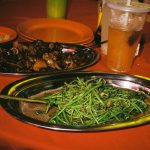Navigating Global Street Food Scenes: Top Tips for Safe Tasting Adventures
Responsible Tourism and Street Food
Engaging with street food can contribute positively to local economies while minimizing environmental footprints. Visitors should focus on supporting sustainable practices and reducing waste.
Supporting Local Vendors
Purchasing from local vendors directly impacts their income and supports community economies. Travelers can seek out stalls owned by locals, fostering a genuine experience and understanding of the area’s culture. It’s beneficial to engage with vendors, asking questions about the ingredients and preparation methods used. This not only provides valuable insights into traditional cooking practices but also builds a connection between visitors and locals.
Sometimes, larger stalls or chains overshadow small family-run businesses. Choosing these smaller establishments ensures that more money stays within the community. Engaging with vendors helps showcase diverse culinary skills and preserves traditional cooking techniques.
Minimizing Waste and Environmental Impact
To minimize waste, travelers should avoid using disposable containers and utensils, opting for reusable options instead. Carrying a small set of utensils and a water bottle can significantly reduce reliance on single-use plastics. Encouraging vendors to use biodegradable packaging can have a broader impact.
In areas where recycling isn’t common, maintaining personal responsibility for waste is crucial. Proper disposal of any packaging or leftovers keeps dining areas clean and pleasant for everyone. It’s important to exercise respectful eating habits, such as finishing the food or politely sharing when portions are large. This reduces food waste and demonstrates environmental awareness. Combining mindful consumption with practical waste-reduction strategies enriches the street food experience without compromising the environment.
Capturing Your Culinary Adventures
Capturing the essence of street food scenes through photography and storytelling can significantly enhance any culinary adventure. From taking the perfect shot of a local delicacy to sharing vibrant experiences online, each step enriches the journey.
Photography Tips for Food Bloggers
Effective food photography starts with natural light. Utilizing daylight can highlight the colors and textures of culinary delights. A simple background helps to keep the focus on the dish, while an interesting angle can provide a unique perspective.
He ensures that every photo tells a part of the story, capturing not only the food but also the ambiance around it. A steady hand or a tripod can prevent blurred images, and he finds that subtle editing enhances photos without losing their authenticity. Careful composition conveys more about the experience, enticing viewers to taste the culinary adventures through the lens.
Sharing Your Experiences Online
When sharing experiences online, an engaging narrative brings the culinary journey to life. By crafting descriptive captions, she paints a vivid picture of the flavors and aromas encountered in different locales. Choosing appropriate hashtags increases reach and connects with fellow food enthusiasts.
Interacting with the audience creates a deeper connection. Responding to comments and engaging in conversations about culinary delights fosters a sense of community. Consistency in sharing content helps maintain follower interest, and she ensures that each post is informative, offering insights or tips that make her culinary adventures relatable and inspiring.



